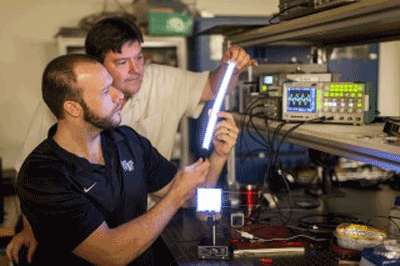New lighting technology could eliminate fluorescent bulbs
BY NICOLETTE EMMINO
Since the middle of the 20th century, fluorescent lighting has been a cheaper, safer, and longer-lasting lighting approach than incandescent lighting, especially in offices. However, these bulbs tend to flicker, produce an irritating humming sound, and can be very hard on the eyes. Now there’s a solution.

Fluorescent light bulbs. (Image via Maine Department of Environmental Protection)
Researchers at Wake Forest University in North Carolina have been working on new lighting substitutes and have developed a flicker-free, shatterproof alternative for large-scale lighting.
“You want lights that have a spectral content that is appealing to us inside of a building,” said David Carroll, lead scientist of the project at Wake Forest.
Their new lighting arrangement is based on field-induced polymer electroluminescent (FIPEL) technology, which gives off a soft white light unlike the yellowish gleam from fluorescents or the bluish tint from LEDs.

Lead researcher, David Carroll, working with graduate student on new FIPEL lighting technology. (Image via Ken Bennett, Wake Forest University)
The team used a nano-engineered polymer matrix to convert the charge into light. The device comprises three layers of moldable white-emitting polymer and a small amount of nanomaterials that glow when stimulated to create bright white light similar to sunlight, which tends to be easier on the human eye.
The lights are not limited to just white. They can be manipulated into any color or shape. You can have a light constructed into 2 x 4-ft sheets to replace lights in the workplace or even into a bulb for your household lamp.
According to the team’s research, when it comes to energy efficiency, the new lighting technology is similar to LEDs, with at least twice the efficiency of compact fluorescent (CFL) bulbs.
“You want a light that won’t shatter and create a hazmat situation while your children are around,“ said Carroll.
Not only are they safe and energy efficient, they will also last a long time. Carroll has one that has worked for about 10 years.
Keep your eyes peeled for this lighting technology to hit your home soon. Wake Forest is currently working with a company to manufacture the new lighting design and plans to have it ready for consumer purchase as early as next year. Carroll sees potential uses for large display lighting, from store marquees to signs on busses and subway cars that won’t exude the bluish tint of LEDs.
For more information about the team’s research, take a look at the research paper below which investigates the use of multiwalled carbon nanotubes (MWNTs) in the new technology. ■
Advertisement
Learn more about Electronic Products Magazine





